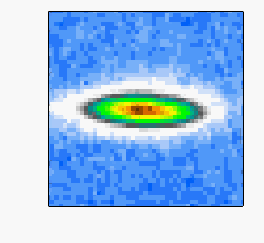
National Institute of Standards and Technology (NIST) researchers have observed for the first time the Hall effect in a gas of ultracold atoms. The Hall effect is an important interaction of magnetic fields and electric current more commonly associated with metals and semiconductors. Variations on the Hall effect are used throughout engineering and physics with applications ranging from automobile ignition systems to fundamental measures of electricity. The new discovery could help scientists learn more about the physics of quantum phenomena such as superfluidity and the quantum Hall effect.
Their paper appeared June 14, 2012, in the online version of the Proceedings of the National Academy of Sciences.
Discovered in 1879 by Edwin Hall, the Hall effect is easiest to visualize in a rectangular conductor like a copper plate when a current is flowing along its length. A magnetic field applied at a right angle to the electric current (down into the plate) deflects the path of the charge carriers in the current (electrons, for example) by inducing a force in the third direction at right angles to both the magnetic field and the current flow. This pushes the charge carriers toward one side of the plate and induces an electrical potential, or "Hall voltage." The Hall voltage can be used to measure the hidden internal properties of electrical systems, such as the concentration of the current carriers and the sign of their charge. (See, for example, The Hall Effect.)
"Cold atom systems are a great platform for studying complicated physics because they are nearly free of obscuring impurities, the atoms move much more slowly than electrons in solids, and the systems are much simpler," says NIST researcher Lindsay LeBlanc. "The trick is creating the conditions that will get the atoms to behave the right way."
Measuring the Hall effect in a Bose-Einstein condensate builds upon previous NIST work generating synthetic electric and magnetic fields. First, the group uses lasers to tie the atoms' energy to their momentum, putting two internal states into a relationship called a superposition. This causes the electrically neutral atoms to act as if they are charged particles. With the cloud of about 20,000 atoms gathered into a loose ball, the researchers then cyclically vary the trapping force—pushing the atoms in the cloud together and pulling them apart—to simulate the movement of charge carriers in an alternating current. In response, the atoms begin to move in a manner that is mathematically identical to how charged particles experiencing the Hall effect would move, i.e., at right angles to both the direction of the "current" flow and the artificial magnetic field.
According to LeBlanc, measuring the Hall effect offers another tool for studying the physics of superfluidity, a low-temperature quantum-based condition where liquids flow without friction, as well as the so-called quantum Hall effect, where the ratio of the Hall voltage and the current through the material is quantized, allowing for the determination of fundamental constants.
L.J. LeBlanc, K. Jimenez-Garcia, R.A. Williams, M.C. Beeler, A.R. Perry, W.D. Phillips and I.B. Spielman. Observation of a superfluid Hall effect. Proceedings of the National Academy of Science. Published online before print June 14, 2012, doi: 10.1073/pnas.1202579109.

